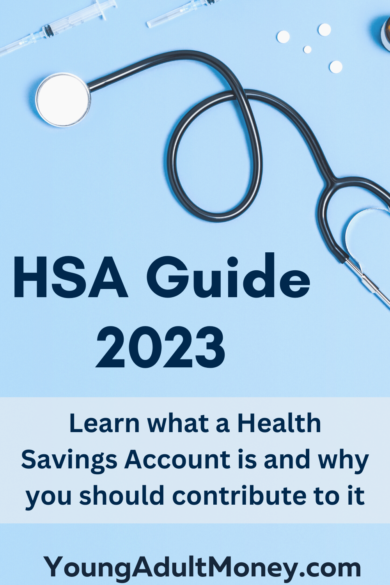 2023 may be your first year with a Health Savings Account, or HSA, and you are looking to understand how it works.
2023 may be your first year with a Health Savings Account, or HSA, and you are looking to understand how it works.
Or, perhaps you may have had an HSA for years but haven’t used it.
It sounds weird, but I love writing and talking about Health Savings Accounts. I don’t think enough people know about the benefits of Health Savings Accounts.
An HSA comes with a number of benefits. It creates a (much-needed) medical emergency fund, has a “triple tax advantage,” and is a retirement account on steroids.
We’ll go through all the details of an HSA in this Health Savings Account guide so you have all the info you need to take full advantage of the benefits. Let’s start by talking about High Deductible Health Plans, or HDHPs. Why start there? Because you need to have an HDHP to contribute to an HSA.
High Deductible Health Plans – What Are They?
HDHPs are health insurance plans that have a relatively high deductible before your insurance kicks in. For example, you may need to spend $3,000 of your own money towards medical costs before your health insurance pays anything. Even though your insurance doesn’t pay anything until you hit your deductible, you would still reap the benefits of having health insurance because you would get their negotiated pricing, which knocks off some of the cost of provider visits, pharmacy drugs, and other costs.
The IRS sets the parameters for what is and isn’t an HDHP. For 2023, the IRS defines an HDHP as any plan with a deductible of at least $1,500 for an individual or $3,000 for a family. As long as your coverage hits those minimums you have an HDHP and are eligible to contribute to an HSA.
$1,500 is actually a pretty low deductible. Many plans will have a deductible of $3,000+ for an individual and $6,000+ for a family. Typically the higher the deductible the lower the monthly premium. The good news is that HDHPs total yearly out-of-pocket expenses are capped by IRS guidelines. These out-of-pocket costs can’t be more than $7,500 for an individual or $15,000 for a family, though this limit doesn’t apply to out-of-network services which could have a cap as high as $10,000+ for an individual or $20,000+ for a family.
You may be wondering how the out-of-pocket max comes into play, since insurance kicks in once you hit your deductible. Well, just because you hit your deductible doesn’t mean that you are done owing money; it just means your insurance will cover most of the costs. You may see something like an 80/20 cost share once you hit your deductible, meaning for a $1,000 bill you would owe $200 and your insurance would cover $800. The out-of-pocket max is the absolute maximum you will pay. If you need an expensive surgery, a hospital stay spanning a few days, or some other expensive event you will likely hit not only your deductible but also your out-of-pocket max.
HDHPs are becoming more popular
Many employees today have no choice but to sign up for an HDHP because it’s the only option that their employer offers. According to a data brief from the Center for Disease Control and Prevention, the percentage of adults aged 18–64 with employment-based coverage that had HDHPs increased from 14.8% in 2007 to 43.4% in 2017. Keep in mind this doesn’t include the millions who get their insurance through the exchanges, which virtually only offer HDHPs.
HDHPs are both good and bad. They are good because they allow for lower monthly premiums. They also can, in some situations, give an incentive for the consumer to shop around. For example, when I got a CT scan a few years ago I would have paid $1,000 if I went to the place my doctor referred me to. Instead I shopped around and paid $300.
The elephant in the room is the large amount of costs it puts on a consumer before their insurance kicks in. I wasn’t surprised in the least when Presidential candidate Kamala Harris in a debate about health care, painted the picture of the mother with a sick infant who was parked outside the emergency room, hoping she wouldn’t have to go in because she knew she could afford a bill of $1,000+.
HDHPs can serve as a “medical emergency fund”
That’s where a Health Savings Account comes into play. An emergency fund is great, but we’ve gotten to a point where even if you have insurance you are exposed to a potential for a big surprise medical bill. This is why the cost of health care is my biggest concern for millennials. Too many don’t have an emergency fund, let alone a separate medical emergency fund. I fully recognize that some are in a position where cash flow is tight and it’s extremely difficult to save money in an emergency fund.
Now that we have a solid background on HDHPs and why it is beneficial to sock away money in an HSA, let’s talk about the specifics of HSAs.
Health Savings Accounts – How They Work and How to Maximize Them
For 2023 the IRS has set contribution limits for HSAs to $3,850 for an individual or $7,750 for a family. For those over the age of 55 there is an opportunity to contribute an additional $1,000.
Most HDHPs will already have an HSA provider set up that you can leverage with your health insurance. If you don’t have one, though, a few of the major providers are Fidelity, Lively, The HSA Authority, and Optum. When picking one you will want to understand any fees they charge as well as the minimum balance required to invest (more on that in a moment).
One important distinction to keep in mind is that an HSA is not a Flexible Spending Account (FSA). FSAs have a silly “use it or lose it” policy where you lose any money that is left in the account at year-end. HSAs stay with you forever. You can switch employers, move to another state, change medical coverage, get married or divorced, or any other number of life changes and your HSA stays with you.
Now let’s get to the tax advantages that come with HSAs, specifically the “triple tax advantage”:
- Put Money in Pre-Tax – Contributions put into an HSA are not taxed. Meaning, your adjusted gross income on your taxes will decrease by the amount you deposit.
- Interest and Investment Gains are Not Taxed – Once your cash balance hits a certain threshold (i.e. $1,000, $2,000, etc.) you can shift any money above the threshold into an investment account. The investment gains are not taxed.
- Withdraw Money Tax-Free – When you withdraw money to cover a qualified medical expense you are not taxed on the withdrawal. You can consult a tax expert on exactly what is and isn’t a qualified medical expense, but in general an IRS-qualified medical expense is defined as an expense that pays for healthcare services, medications, or equipment. Clear-cut examples include a prescription you get at a pharmacy or a bill from a doctor visit.
One reason I call HSAs a “retirement fund on steroids” (no pun intended) is because after the age of 65 you can withdraw money from your HSA for non-medical expenses without incurring a 20% penalty. You will still have to pay taxes on the withdrawal, as this withdrawal would be treated similar to a withdrawal from an IRA. But you also have the option of withdrawing funds for qualified medical expenses and pay no taxes at all, regardless of your age. Meaning, an HSA acts similar to a standard IRA retirement account with the (huge) added benefit of potentially taking out the funds tax-free if you have medical expenses. With the way health care costs are going and with people living longer, there’s a very good chance you will have many qualified medical expenses when you are 65+.
A final benefit I want to point out is that you can use it for anyone in your household. What I like about this is that if you are caring for and covering the medical bills of a parent, sibling, or child, you can leverage your HSA to pay the bills tax-free. This could be invaluable if you have a sibling or child with a disability who you anticipate caring for long-term.
Health Savings Accounts – Strategies to Maximize
Whether or not you contribute to an HSA – and how much you contribute – depends entirely on your individual financial situation. You can talk this over with a financial advisor or money coach. With that being said, here are a few strategies to maximize HSAs:
- Deposit as much as possible, as early as possible. While I don’t have research or a robust data set, what I’ve seen is that people tend to only contribute to an HSA if they have medical issues. If someone is relatively healthy they don’t contribute. I will admit my wife and I didn’t max out our HSA until after we had a pair of surgeries and realized how important it was to have money set aside ahead of time.
- Shift your money out of cash and into investments as soon as possible. The HSA I have has a threshold of $2,000. I log in every two weeks and if my balance is above $2,000 I shift every dollar I can to investments. Now that I have some traction my ultimate goal is to get my HSA to $100k.
- Never use the debit card the HSA provider sends you. Instead, use a rewards credit card and then simply reimburse yourself through your HSA. HSA providers are making money each time you swipe their card, but they aren’t sharing the wealth with you. There is no requirement to use their debit card, so you should be using a solid rewards credit card instead.

